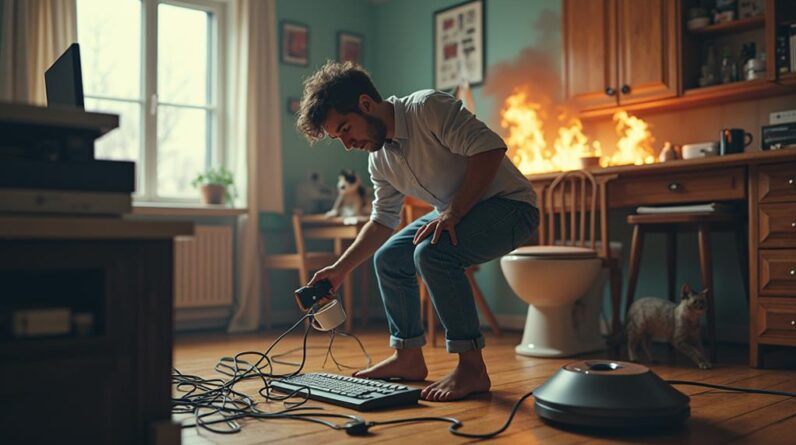
Sponsored by SurfShark VPN. Click on the link in the description and enter
promo code UNDECIDED for 83% off and 3 extra months for FREE! It took a while, but I finally got my Tesla
Powerwall installed. There’s a few things I learned going through
the process that might be useful if you’re thinking about getting a home battery installed. So let’s go through what you should know
before getting a Tesla Powerwall.
And … my first impressions of it. I’m Matt Ferrell … welcome to Undecided. First off, I want to thank all of you who
used my Tesla referral code over the past couple of years. This Powerwall, as you can probably tell by
the color, is a founders edition Powerwall that I earned through the referral program. So I only had to pay for the installation,
but I’ll run through all of the costs and my first impressions in a bit. Getting this installed was a bit of a comedy
of errors. There wasn’t one big gotcha or anything
like that, but just a bunch of small road bumps and blips that collectively made it
an incredibly frustrating, almost 4-month-long experience. And it’s what I learned from that that I
want to share with you so you know what to look for, what to ask, and what to expect.
While my path had some bumps, I’ve still
got a fully functional Powerwall that’s already impressed me … a lot. There’s two basic categories of things you
should know about when installing a home battery. First is understanding what your energy requirements
are. It’s the same thing you’d need to know
if you’re getting solar, but with a battery system it’s important because of the electrical
load it’s capable of supporting. If you don’t have an energy monitoring setup
in your home, which I do with Sense, then you can get a ballpark figure by looking at
your electric bill. Just look at the kWh used each month to see
how much electricity you use on average.
And then create a list of your major appliances
and items around the house like HVAC, refrigerator, stove, pool, etc. and write down their power
draw in watts. You can usually find this on labels on the
device or online. If you add them all up, you’ll start to
get a high level sense of what your home might use in kW if everything was turned on. There’s some good reasons why doing this
is important. I’ve covered this in a previous video, but
home batteries have limitations for their continuous power output. The Powerwall has a cap at 5kW continuous
power with a peak load up to 7kW. These limitations are per Powerwall. So if you have 2, you’d have a max of 10kW
continuous power output available. So you can probably see where I’m going
with this. Take the number from your appliance tally
and you’ll understand how many Powerwalls you might need to support 100% of your use
if everything was running.
In my case, one Powerwall isn’t quite a
enough, but that’s totally fine. It really depends on what your goals are with
battery backup. For me I’m most interested in providing
a base level of backup to keep things like the heat going in the winter during a power
outage, and to keep the refrigerator from defrosting. If you’re like me and your goal isn’t
100% coverage, there are a couple of options. One path is what I have here. This Powerwall is backing up my entire electric
panel, so in theory everything in the house “could” run during a blackout … just
not all together. The other path I could have taken was adding
a sub panel which would carve out essential load circuits. That sub panel could have had my HVAC, refrigerator,
and a few other items in there. Then the Powerwall would only backup that
group and everything else in my house would go dark in a blackout.
Going into this I had a basic understanding
of that, but didn’t really think about it until I was well into the process of getting
it installed. The installer I went with, which was not Tesla,
didn’t walk me through my options. They were just going to do a straight install,
but never even brought up other things I might want to consider doing. When I realized that was the case I started
asking questions, which caused a brief delay to the installation date. This was my first road bump in the install
process, which is why I bring it up. Make sure you do a bit of homework before
you leap in because there’s no guarantee your installer is going to be proactive and
inform you of your options up front.
Whichever path you choose for your setup,
you might want to consider getting a soft start for appliances like your HVAC. As I mentioned, the Powerwall has a peak load
capacity of 7kW, but when you push into that zone, you risk tripping the Powerwall’s
emergency shutdown if you overload it when something like your HVAC kicks on in a blackout. Major appliances like that can have a sizable
spike in power draw when the motor kicks on, so a soft start can dramatically shave off
that power spike.
Some installers recommend doing that as par
for the course. Mine didn’t, but I may add one down the
road. Again, knowing this kind of thing up front
means you can ask the right questions of your installer. And if you’re installing this with solar
and want to ensure that your home can go indefinitely in a power outage, you need to make sure you’re
balancing the battery’s power capacity with the output capacity of your solar panel system. If your solar panels can output more power
than your battery can take in, the battery system will have to shut off the panels during
a blackout at times to manage that intake. Otherwise it’s too much power for the battery
to handle. The second category of things to be aware
of is all around how prepared your home is to handle a Powerwall.
And the first thing you have to look into
is … do you have a service disconnect switch? To my knowledge, I’ve never lived in a house
with a separate service disconnect switch. It’s standard procedure for new homes, but
all of the older homes I’ve lived in haven’t had one. They’re usually just gigantic switches near
the power meter, or sometimes on the meter box itself.
My house didn’t have one. The main circuit breaker in my panel was acting
as the service disconnect too. Well, with a Powerwall, or any battery system
for that matter, you’re going to need a service disconnect. That bit me in the butt when one of the electricians
stopped by the night before the install to scope out the setup in person.

He spotted the lack of a service disconnect
right away, which delayed the project significantly. They had to coordinate with the electric company
for shutting off the service temporarily and had to install a disconnect at the same time
as the Powerwall. I’m still not sure why they didn’t include
any questions about this in the self-evaluation form I filled out, or why nobody caught it
in the photos I took. That’s the next big road bump that I experienced,
which brings me back to asking a lot of questions up front. You can’t rely on your installer having
procedures in place to mitigate that type of thing happening … but in my opinion,
a good installer should have that covered, like having a simple question about service
disconnects in the self-evaluation. If it’s required, they should confirm you
have it upfront. Happily, this next one wasn’t a road bump
for me, but be sure you select a place with plenty of space. The Powerwall comes with a Gateway, which
is what manages where the power goes. It’s the brain of the system.
The gateway needs about 2 feet of width and
3 feet of height. And the Powerwall itself requires 4 feet by
5 feet for each Powerwall, and about 6 feet open in front of it.[^1] And you need a really
good Wifi connection in the area of the Gateway or an available ethernet jack for a wired
network connection. Overall, my installation experience was not
great. It wasn’t one big thing that caused problems. It wasn’t one person’s fault that I got
hit with lots of delays. It wasn’t 100% the installers fault … and
I’m not blameless in this either. The Powerwall arrived at my home on July 29th,
but wasn’t installed and activated until November 20th. Almost 4 months. Some of my late questions caused delays. The lack of a service disconnect switch caused
more delays.
Some really bad communication issues with
my installers left me in the dark for the better part of 7 weeks. They fixed that, but one of the giant issues
behind the scenes was 2020 itself. COVID caused issues for my installer and made
scheduling very tough. But my favorite moment of the whole thing. The day they installed the Powerwall the electrician
discovered that there was a missing part … a communications wire harness, which probably
costs about a $1 (or less). So the whole thing was setup, but couldn’t
be turned on for several more weeks because of that one tiny part.
And when the final setup was completed a different
electrician ran a new set of communication cabling on the outside of the conduit even
though the previous electrician supposedly already ran some inside. I’m not thrilled about that … but the
system works. If I get a second Powerwall, I’ll most likely
get that fixed up. But to be very clear, my experience isn’t
normal and none of you should think this is what your experience will be like too. Since this was a referral reward, I was given
the option of having Tesla install it, or selecting my own installer and they’d ship
it to me directly. That’s the path I went. For all of you out there, your installer will
show up with the Powerwall on the day they install it, so you won’t have a Powerwall
sitting on your garage floor for months … me … I chose my option … poorly. I should have let Tesla do it. As for the cost, the installation cost $2,500
including the cost of installing the service disconnect switch. That would have made the total cost with the
Powerwall and Gateway about $10,500. The price is going to vary based on your specific
situation and what you want done, like having a sub-panel installed for essential load carve
outs, and any other upgrades needed to support a home battery.
I got installation quotes that ranged from
the $2,500 I paid up to almost $7,000, so shop around. But how’s the Powerwall? Before I get to that, I’d like to thank
Surfshark for sponsoring this video. I know we’re not traveling much right now,
like me being stuck at home with my Powerwall for months, but I still like to use a VPN
when I want to protect my privacy online. SurfShark encrypts all of the data you send
over the internet, so your passwords, messages, photos, videos, and whatever you’re doing
online … stays private. A lot of online services use some pretty sophisticated
commercial targeting and tracking … a VPN can protect you from that. With SurfShark’s CleanWeb, it will block
ads, trackers, and malicious websites making it safer to use the internet even at home. One of the best parts of SurfShark is that
it’s easy to set up on all your devices whether that’s iPhone or Android, Mac or
PC. SurfShark is the only VPN to offer one account
to use with an unlimited number of devices.
Use my code to get 83% off plus 3 extra months
for free! SurfShark offers a 30-day money-back guarantee,
so there’s no risk to try it out for yourself. Link is in the description below. Thanks to Surfshark and to all of you for
supporting the channel. So how is the Powerwall? Well, it’s kind of awesome. I’ve only had it up and running since the
end of November, but I’m super impressed by it all ready. If you’ve seen any of my solar panel videos,
where I go in depth on how my system has been working out, you’ll know that the winter
time is my lowest solar production. So this time of year isn’t going to keep
my battery full by any stretch … BUT … I’m very excited for this as just a battery backup
for winter power outages. Anyone that lives in the Northeast knows what
I’m talking about. Nor’easters, freezing rain, strong winds,
really heavy wet snow, it can all take down tree limbs and power lines, so power outages
aren’t uncommon.
In my area they might only last for a few
hours, but we’ve had a couple that lasted for a day or two. The Powerwall has some really nice controls
for managing this type of thing. I absolutely love the Tesla app UI for this,
by the way. I’m mesmerized by the Power Flow screen
that shows exactly where your energy is coming from and going. I can’t stop checking it out. I even figured out how to get it showing up
in Apple Home. Anyway, in the app you can configure how the
battery should work. There’s three basic modes: backup-only,
self-powered, and advanced. Backup-only shouldn’t need an explanation. Self-powered, which is what I have it set
to, will store excess solar power production for use when there isn’t sun.
In here you can configure how much of the
battery should be reserved for backup power. Since this is the lowest point of the year
for me for solar production, and I want to maximize the backup potential for storms,
I’ve set it to 50% for now. The Advanced option is really meant for people
who have time-of-use rates. It will charge and discharge the battery to
maximize savings for you. Where I am in Massachusetts, we don’t have
time-of-use, so that’s not a good option for me. But within the first couple of weeks of having
this up and running we got a really bad snow storm that came through. Really heavy, wet snow and high winds, which
ended up knocking out power for lots of people around New England. We didn’t lose power, but I got to see Storm
Watch in action for the first time.
The system detected the storm warning and
automatically charged my battery up to 100% the night before the storm and kept it there
for the duration. Locked and loaded and ready to go. That alone made the long wait so worth it. It’s that type of automation for emergency
backup that got me so excited for the Powerwall. There’s a lot more I could go into about
this, but I’m going to wait until I’ve gone through the winter and gotten some better
solar production as well. I’ve also applied to be part of a virtual
power plant system with my Powerwall, so I’m hoping to be able share about that as well. Be sure to subscribe at hit the notification
bell to not miss out on my full-on review of the Powerwall and my experiences with it.
I hate being that YouTuber asking for you
to “hit that bell” … can’t stand saying that … but it’s the only way to be sure
you don’t miss out on new videos. Only about 12% of you have done it by the
way, so let’s see if we can get that up to 15% … heck, let’s live a little … 20%! Now jump into the comments and let me know
what you think about the Powerwall or home batteries in general. Do you have one? Want one? If you liked this video be sure to check out
one of the ones I have linked right here. Be sure to subscribe and hit the notification
bell if you think I’ve earned it. And as always, thanks all of my patrons and
to all of you for watching. I’ll see you in the next one..
As an Amazon Associate I earn from qualifying purchases.







